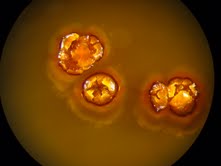
Secondary Metabolites
 Table of Secondary Metabolites and Their Chemical Structures
Table of Secondary Metabolites and Their Chemical Structures
Look back at the phylogenetic tree of marine actinomycetes and notice how many are still undiscovered! Now imagine how many amazing and incredibly potent medications can be made from these single celled organisms! Below is a table of the secondary metabolites that these bacteria produce. This may not be all marine actinomycetes, but the table below covers a lot of the compounds produced by the genus Salinospora (table is a reproduction from http://aem.asm.org/cgi/content-nw/full/73/4/1146/ by Paul Jensen).
|
Secondary Metabolite |
Salinispora Species |
Biological Target |
Molecular Target |
|
Salinisporamide A |
S. tropica |
Anticancer |
Proteasome |
|
Sporolide A
|
S. tropica |
Unknown |
Unknown |
|
Rifamycin |
S. arenicola |
Antibiotic |
RNA polymerase |
|
Staurospoine |
S. arenicola |
Anticancer |
Protein kinase |
|
Saliniketal |
S. arenicola |
Cancer chemoprevention |
Ornithine decarboxylase |
|
Arenicolide |
S. arenicola |
Unknown |
Unknown |
|
Cyclomarin A |
S. arenicola |
Anti-inflammatory |
Unknown |
|
Cyanosporaside A |
S. pacifica |
Unknown |
Unknown |
|
Salinispyrone A |
S. pacifica |
Unknown |
Unknown |
Let's dissect this table. First lets look at the secondary metabolites that Salinispora tropica produces. As you can see there are two secondary metabolites on this table that were known about at this time. Since this table was produced another secondary metabolites has been discovered. This compound is called Lymphostin. It has been synthesized and is used as an immunosuppressant during chemotherapy.
Notice that Sporolide A is on this table. This compound has been extensively studied and so far it is still unknown what this particular secondary metabolite might do medicinally. So far it is only known that it is not anti-cancer or anti-biotic. I'm sure however that it is only a matter of time until this mystery is solved!

The most extensively studied secondary metabolite is Salinisporamida A. This compound fights cancerous cells by targeting the proteasome inhibitor and killing the cancer from the inside out. Salinisporamida A has been shown to be 100% effective at proteasome inhibition and has not shown the same level of cytotoxicity as the leading proteasome inhibiting cancer drug Velcade. This natural product seems very promising for the treatment of many different types of cancer!
Salinispora arenicola was the next of this genus to have a full genome found. This organism has many more secondary metabolites both found and hypothesized. The first of these I want to explain is Rifamycin. This is a very potent antibiotic that has been used to treat tuberculosis and other emergency infections. By attacking the bacterial RNA of the pathogen it is able to effectively rid many organisms of bacterial, eukaryotic, and viral infections.
Staurosporine is another interesting metabolite and is very diverse in its effectiveness against disease. It has been found to have anti-fungal and anti-biotic properties, as well as being a blood pressure reducer. More importantly it is anti-cancer by means of protein kinase C inhibition. Through studies it has been found to be three orders of magnitude (1000X) stronger than the most popular protein kinase inhibitor on the market. It is also very cytotoxic to tumors and inhibits platelet aggregation. Isn't it amazing how many cancer treatments are popping up? Here is another organism that fights cancer!
Saliniketal is used in a process called chemoprevention. This means that once damaged cells have been identified, they are targeted before a malignancy occurs. This is the hope with this secondary metabolite
 which targets cells in the renal system.
which targets cells in the renal system.The next group of secondary metabolites specified at the table at the top of this page is Arenicolide A. It is unknown what this particular compound does. However, the final compound produced by Salinispora arenicola is Cyclomarin A and this one is well studied. It is both anti-inflammatory and anti - fungal.
The next marine actinomycete on the list is one that is new. It has not received a final name yet, however the name proposed is "Salinispora pacifica." Because it is so recently discovered the secondary metabolites it produces are not well understood, as the table above states.
Learn about a new and exciting cancer treatment!
Home